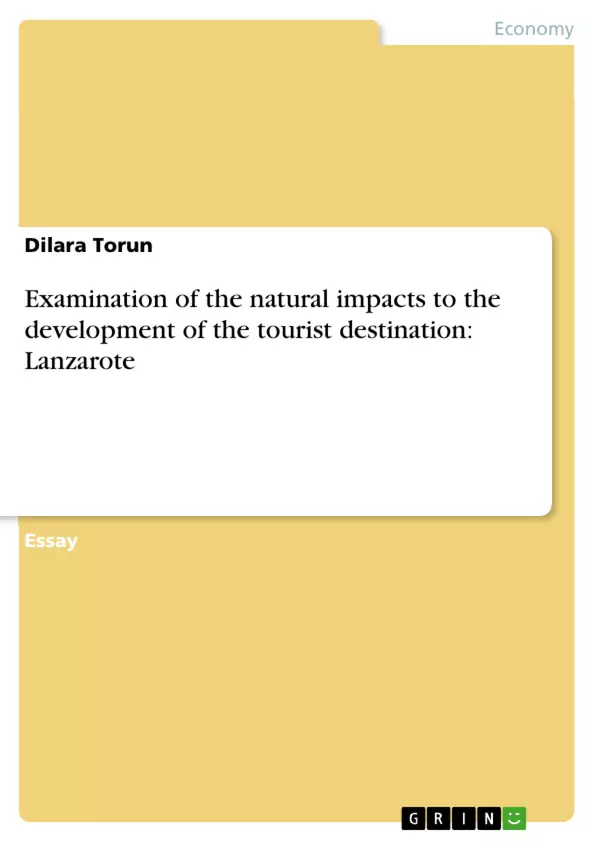There are different impacts that the development of tourism has on a destination, for instance,
natural or environmental, economical, political or socio-cultural. The environment is one of
the most important issues for the development and promotion of a tourist destination, and also
the most fragile (Franco and Garcia, 1999).
Due to the huge influx of tourists known as “mass tourism”, the impacts of the development
can be positive and negative. Positive economic impacts are the improvement of infrastructure
and the attraction of more investment in the area; negative the increase of prices and of
income inequality. Positive socio-cultural impacts enhance the increase of cultural exchange
and restoration of buildings; negative socio-cultural like immigration and assumption of the
stereotypes of tourist; and finally, negative environmental impacts like noise, pollution,
destruction of the natural environment, huge buildings in natural areas, overuse of water,
problems with the treatment of wastes, water pollution by liquid waste, destruction of
historical monuments, air pollution from the use of vehicles and heating, changes in the
landscape to promote activities entertainment and sports such as golf; etc. But not only mass
tourism affects on the environment, alternative tourism can also make an unsustainable use of
resources (Garcia and Sancho, 1999).
This essay will examine critically the natural impacts that the development of tourism has
upon the destination Lanzarote. This Spanish island is famous for its unique volcanic
landscape and its biosphere reserve. The island of Lanzarote is within the 10 most popular
islands of Europe (Trivago, 2009) and personally one of my favourite travel destinations due
to family reasons. (1606 words)
Inhaltsverzeichnis (Table of Contents)
- Introduction
- Lanzarote: location and characteristics
- Environmental aspects of Lanzarote
- Biosphere Reserve by UNESCO
- Natural impacts and key environmental sectors
- Conclusion
- References
Zielsetzung und Themenschwerpunkte (Objectives and Key Themes)
This essay critically examines the natural impacts of tourism development on the island of Lanzarote. It focuses on the island's unique volcanic landscape and its status as a UNESCO Biosphere Reserve. The essay explores the challenges and opportunities presented by tourism's growth in this fragile environment.
- The environmental impacts of tourism development on Lanzarote
- The significance of Lanzarote's designation as a UNESCO Biosphere Reserve
- The balance between tourism development and environmental protection
- The role of sustainable tourism practices in preserving Lanzarote's natural heritage
- The potential for future challenges related to tourism growth on the island
Zusammenfassung der Kapitel (Chapter Summaries)
The introduction explores the various impacts of tourism development on destinations, highlighting both positive and negative consequences. It focuses on the environmental challenges posed by mass tourism and introduces Lanzarote as a case study.
Chapter 2 provides an overview of Lanzarote's location, geography, and key characteristics. It discusses the island's volcanic landscape, its population, and its designation as a UNESCO Biosphere Reserve. This chapter also highlights the island's unique cultural heritage and its commitment to sustainable tourism.
Chapter 3 delves deeper into the environmental aspects of Lanzarote, focusing on its status as a Biosphere Reserve and the factors contributing to this designation. This chapter discusses the island's natural areas of interest, its environmental culture, and its management tools for ensuring the protection of its natural resources.
Schlüsselwörter (Keywords)
The key focus of this essay is on the environmental impacts of tourism development, specifically on the island of Lanzarote. The main keywords include tourism development, environmental impacts, Biosphere Reserve, volcanic landscape, sustainable tourism, and conservation.
- Citar trabajo
- Dilara Torun (Autor), 2011, Examination of the natural impacts to the development of the tourist destination: Lanzarote, Múnich, GRIN Verlag, https://www.grin.com/document/183441



